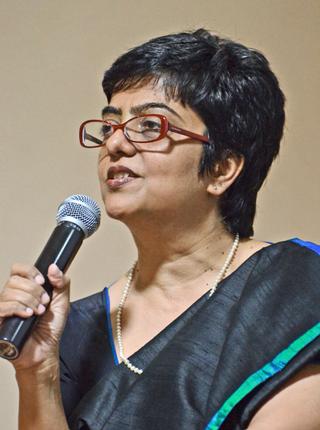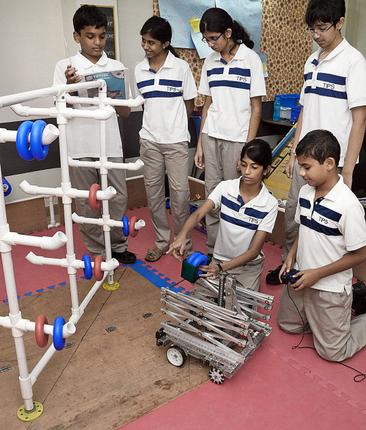Homeschooling uses the head, heart and the hand to impart learning, say parents who have chosen it over conventional schooling for their children.
Two-and-a-half years ago, Aum spent his days at a local school in Alandurai, where his parents Nisha Srinivasan and Ragunath Padmanabhan live on an organic farm. One day he returned home unusually thrilled, saying, “Everything the teacher taught today, I understood!”. “What did she teach you?” asked Nisha. “She held up a plant and spoke of its flowers, roots, stem and leaves,” smiled Aum. In her journey of questioning conventional education, that was Nisha’s defining moment. “In a full school year, why was he truly happy only on one day?” she asked. For Nisha and Ragunath, the answer lay in homeschooling Aum.
Today, Aum rises with the sun, spends his morning working the farm with his parents, his day reading, drawing, playing and learning, and his life in tune with Nature’s rhythms. The family is one among Coimbatore’s few homeschoolers, each founded on American educator John Holt’s belief that “living is learning”.
“Reading, writing and math has to therefore, be designed around the context that has the most meaning, interest and value for the child,” says Nisha. For Aum, questions of the world around him arose as he sowed, reaped, made mulch and watched Nature. “Why do bees hover over flowers? Why do seeds look different?” he’d ask. An exploration of pollination or plant species through observation, conversation, books, pictures and videos would ensue. “He now understands monocots and dicots with his hands,” says Nisha.
“Homeschooling looks at education as equal measures of learning with the head, heart and hand,” says Santhya Vikram who follows the Waldorf system of education. For instance, her daughter Kimaaya, spends as much time knitting and cycling, as she does learning Malayalam or telling stories. At nine, she knits bags on order, cycles Coimbatore unaided and can host a self-cooked dinner for her family, besides having age-appropriate reading, writing and math skills. The process of homeschooling Kimaaya, however, began with one of ‘unschooling’. “At school, I noticed Kimaaya losing her sense of independent opinion, lacking curiosity and giving into conventional thinking patterns,” says Santhya. So Kimaaya’s first few months at home were spent absolutely free, losing the rhythms of regular school and eventually finding her own. “We began following the Waldorf grades in Math and English only when Kimaaya herself was curious enough about learning,” says Santhya.
Homeschooling is not about replicating conventional schooling at home explains Chitra Rajendran, one of the city’s earliest homeschoolers; neither is it about parents unloading their knowledge baggage on the child. “It’s a process of exploring answers to questions pertinent to our world, together,” she says. Chitra, therefore, had to confront her shortcomings (math, for example) and be honest about them to her children as well. Nisha concurs, “I was my biggest challenge to homeschooling Aum. I had to learn to be present for him always and be alive to our surroundings together.” As a result, Santhya says that in the initial days, Kimaaya almost shadowed her. “We eventually worked out a schedule where we did spend considerable time together but also equal amounts apart — in the same room maybe, but doing our own thing.”
Most homeschoolers also consciously engage in giving their children varied life experiences. “I’m often asked how my daughter will learn to interact with other children if she’s homeschooled. But education must prepare you for real life and there, we’re never in an environment where everyone is our age! So we travel often, to learn of, and imbibe from, other’s lives and cultures,” says Chitra. For the sheer commitment and involvement required from parents, most homeschoolers say the model isn’t everyone’s blanket solution to conventional schooling’s loopholes. “We often start this journey with anti-establishment sentiments, but one’s motivation must be from a deeper place (without negativity) for it to last. To let go of textbooks and tests, I had to be unschooled first,” says Chitra.
Homeschooling lets children set personal goals for learning with self-defined measures of progress. “Kimaaya, for instance, goes back to her earlier writing to see how she’s grown. She’s today a more confident person with views of her own,” says Santhya. “Aum once saw the world in black and white terms, now there are many shades of grey. There’s nuance to his questions and observations, and a better understanding of ambiguity,” adds Nisha. For homeschooler Giri Leo, the approach’s greatest advantage is its gift of time: “We’re now together enough for real conversation, family bonding and most importantly, for spiritual growth.” Does the system, however, close doors for children’s academic future? Absolutely not, believes Santhya. “In fact, it opens many more; because homeschooling makes children self-sufficient through one all-important skill — the ability to learn anything.”
March 28, 2013
http://www.thehindu.com/todays-paper/tp-national/tp-tamilnadu/at-home-in-school/article4560917.ece
Story behind the story
This was an interesting story to do because the home-schooling community are a people of deep-rooted convictions for it takes that to live such radically different lives. To get to the bottom of those convictions, I had some very long conversations with each of the people mentioned in the story. With Chitra especially, our lines of thought traveled through all the spheres of homeschooling and went on into prayer, spirituality and purpose. It’s when I rediscovered the incredible privilege this profession gives me : the ability to have meaningful and fulfilling conversation with absolute strangers; the chance to discover fascinating people.









